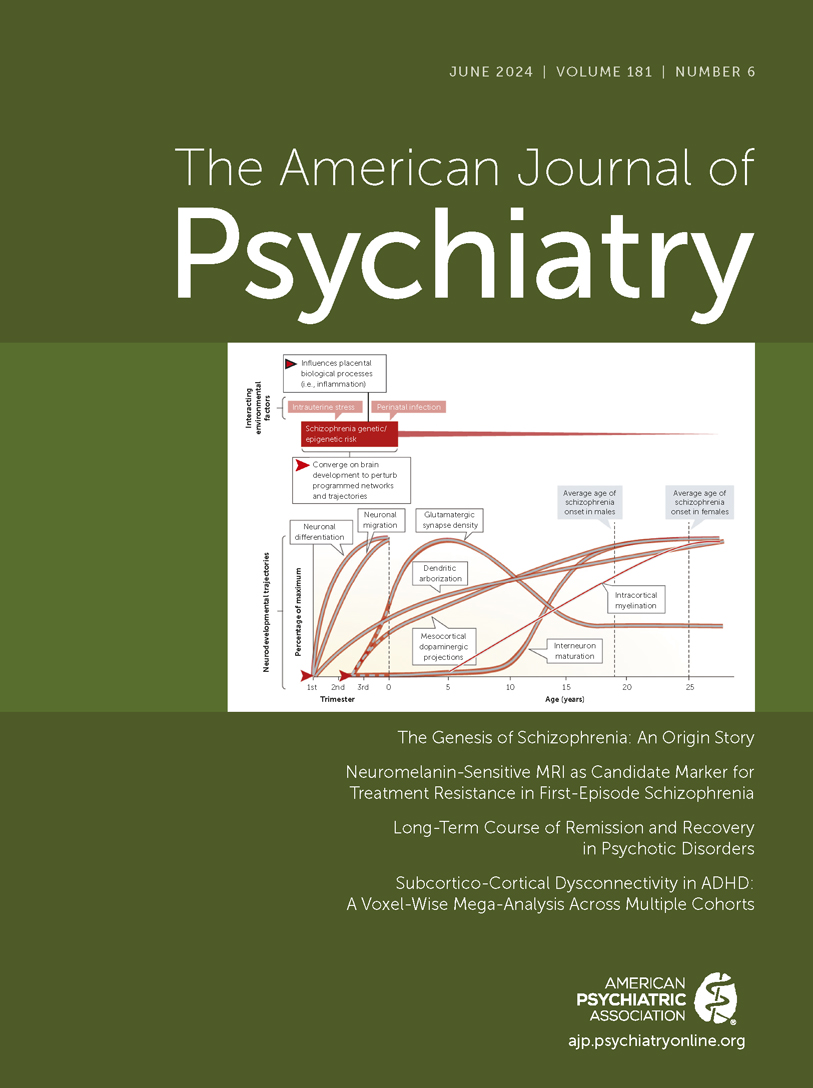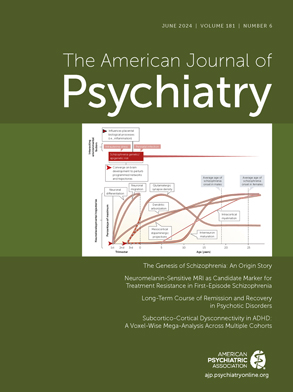Ever since the seminal report of human induced pluripotent stem cells (hiPSCs) in 2007 (
1), and from it the implication that patient-specific cells of any type could be differentiated for models of development and disease, the pressing question has been “How closely do stem cell–derived cells recapitulate those in the original donor?” Particularly given that cellular reprogramming erases epigenetic, transcriptomic, and even morphological markers of age in hiPSCs and their differentiated progeny (
2,
3), it is important to note that hiPSC-derived neurons most resemble fetal brain tissue (
4,
5) and so are generally held to be best suited for studies of disease predisposition rather than late-stage disease.
With respect to schizophrenia, the very earliest stem cell reports (
6,
7) indeed reproduced the most basic cellular phenotypes long reported in postmortem analyses: reduced neurite outgrowth (
8) and synaptic density (
9). Subsequent stem cell findings, across idiopathic (
10), syndromic rare deletions of 22q11.2 (
11) and
NRXN1 (
12,
13), high polygenic risk (
14), and even isogenic CRISPR-engineered studies of common variant lines (rs4702 [
15] and rs1198588 [
16]), demonstrated reduced synaptic maturation, decreased glutamatergic synaptic activity, increased GABAergic synaptic activity, and/or impaired depolarization-induced calcium signaling associated with schizophrenia risk variants. But critically, while all these studies made comparisons between carefully matched hiPSC-derived neurons from case and control subjects, none simultaneously made comparisons of postmortem brain tissue obtained specifically from the same individuals. Thus, the extent to which stem cell–derived neurons recapitulate signatures from the original donor brains themselves remains an open question.
In this issue, Sawada et al. (
17) describe a novel resource that makes it possible to directly compare hiPSC-derived neurons with their donor-matched counterparts in the postmortem brain, by reprogramming fibroblasts isolated from postmortem dural tissue from four neurotypical males and four males with schizophrenia. From a preexisting postmortem collection, the authors specifically selected individuals with extreme polygenic risk scores (PRSs) for hiPSC derivation: four control individuals with low PRSs and four individuals with schizophrenia with high PRSs. (Athough hiPSCs were generated from four schizophrenia donors, only three were used for subsequent comparisons.)
But what type of hiPSC neuron and postmortem brain region to compare? Given that the striatum shows disrupted function and connectivity in schizophrenia and is principally comprised of GABAergic projection neurons carrying either D1 or D2 dopamine receptors, the primary target of most antipsychotics used to treat schizophrenia, the authors set out to establish a novel and more physiologically relevant model of human striatal development in a dish. Following upon insights gleaned from decades of neurodevelopmental studies, the authors directed human striatum development by ventralizing neural cells with a Wnt signaling pathway inhibitor and a sonic hedgehog agonist. The resulting brain organoids, termed “ventral forebrain organoids” (VFOs), expressed representative marker genes of the ganglionic eminence within 2 weeks, with more robust levels evident by day 37. Single-cell RNAseq profiles at later time points, days 70 and 150, did not substantially differ from each other, except for modest upregulation of synaptic genes with further maturation. Inhibitory neurons at both time points expressed markers of immature medium spiny neurons (MSNs), but only rarely did those genes associate with fully mature D1 and D2 receptor MSNs (see Figure 1 in the article). As expected, extracellular recording of spontaneous electrical activity (albeit from one control donor only) showed increased neuronal activity and network burst activity over time, which was increased by a GABAA receptor antagonist and blocked by a GABAA receptor agonist.
Consistent with numerous reports in the field highlighting the magnitude of interdonor effects in stem cell models, the authors report that, independently of diagnosis, the genetic background of hiPSC lines leads to considerable variety in cell type composition. While there were no significant differences in cell type composition between VFOs from individuals with schizophrenia (N=3 donors) and control individuals (N=4 donors), diagnosis-dependent transcriptomic differences within both the progenitor and inhibitory neuron populations were uncovered (see Figures 2 and 3 in the article). The authors report 575 differentially expressed genes (DEGs) (243 upregulated and 332 downregulated) in progenitors and 144 (45 upregulated and 99 downregulated) in neurons derived from the schizophrenia cases. These DEGs included several genome-wide association study (GWAS)–significant genes. Schizophrenia case-derived progenitors showed downregulation of cell cycle genes and upregulation of neurodevelopmental genes; moreover, patient-derived inhibitory neurons likewise revealed upregulation of synaptic genes. Overall, these results suggest accelerated differentiation of striatal neuronal cells in individuals with schizophrenia relative to control subjects.
The authors next applied their single-cell RNAseq data to generate a velocity field map of striatal neuron differentiation within the VFOs, applying latent time analyses to query developmental trajectories of striatal cells between case and control subjects. Consistent with the transcriptomic differences they reported, there were more cells at later developmental stages in the progenitor and inhibitory neuron populations in schizophrenia VFOs (see Figure 4 in the article). This analysis further identified putative driver genes of the observed accelerated maturation; in both progenitors and inhibitory neurons, driver genes overlapped with GWAS and/or transcriptome-wide association study (TWAS) target genes. Of note, the overlap of driver genes and TWAS-significant genes was specific to transcriptomic imputation predictions made from postmortem caudate tissue but not dorsolateral prefrontal cortex. Consistent with these findings, schizophrenia VFOs had reduced neuronal activity, suggestive of increased GABAergic inhibition. Altogether, the authors propose an accelerated striatal developmental trajectory in schizophrenia, suggesting that a subset of schizophrenia risk genes specifically regulate striatal neurodevelopment and thereby contribute to schizophrenia etiology.
Even though, as expected, inhibitory neurons in the organoids showed greatest transcriptional similarity to developing fetal striatal neurons, these cells nevertheless recapitulated the schizophrenia-associated signatures seen in adult brain tissue (see Figure 5 in the article). Of note, this overlap was also brain region specific, observed in postmortem caudate but not dorsolateral prefrontal cortex. Upregulated genes in inhibitory neurons in schizophrenia VFOs showed a significant overlap with upregulated genes in postmortem caudate, of 154 individuals with schizophrenia compared with 245 control individuals (
18), including the donors of the hiPSC cohort. This is an important finding, although it would have been more impactful if it had included donor-level resolution. To what extent do transcriptomic perturbations observed in each individual with schizophrenia correlate between in vitro VFO and postmortem striatal tissue? Did the patient with the most drastic acceleration of striatal neuron development in vitro likewise show the most severe clinical outcome or the most extreme postmortem gene expression signature? Overall, the authors demonstrate that striatal neurons derived from individuals with schizophrenia have transcriptomic signatures that may have originated during early striatal development.
The findings presented likewise inform a new controversy concerning the similarity of postmortem human neurons to their live counterparts (i.e., comparisons of neuronal transcriptomic profiles from cadavers and discarded surgery tissue). Previously, a comparison of human prefrontal cortex gene expression between 275 living samples and 243 postmortem samples showed vast differences in gene expression for nearly 80% of genes, overall implying that postmortem brain gene expression signatures of Alzheimer’s disease, schizophrenia, Parkinson’s disease, bipolar disorder, and autism spectrum disorder may be inaccurate representations of disease processes occurring in the living brain (
19). At issue is whether RNA from the living brain tissue samples was of equivalent quality to the postmortem samples (
20). The present study further supports not only the value of postmortem analyses, but also the extent to which these disease signatures can be subsequently recapitulated in vitro using stem cell models.
In demonstrating that their hiPSC-based model successfully recapitulated schizophrenia-relevant cell type–specific neurodevelopmental phenotypes in a dish, Sawada et al. lay the foundation for an array of future studies. Postmortem analyses are necessarily static, capturing differences in gene expression at a specific moment in time, and typically reflecting late-stage disease. Moving forward, genetic (e.g., introduction or removal of GWAS risk variants) and/or environmental perturbations (e.g., stress, drug exposure, antipsychotic response) can be combined with this human striatal development model to inform the dynamic nature of schizophrenia signatures.

